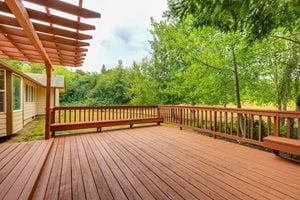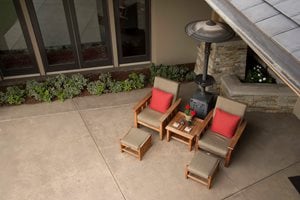A deck is a raised structure that can sit a few inches above grade or elevated several feet when supported by joists or concrete pillars. Because they are raised, decks work well on sloping or uneven ground, so the terrain is rarely a limitation. While sloped properties can be more of a challenge for building a concrete patio, it is often possible with the use of segmental retaining walls.
Weight Restrictions
An important consideration for a raised or elevated deck is the weight it can safely support. Many municipalities require a permit before building a deck because it’s often attached to the home and needs to have adequate strength for the expected use. That means you’ll need to determine what outdoor furniture and activities you want the deck to support and make sure everything fits within the weight limitations. Heavy items like outdoor fireplaces or pizza ovens are often better suited for patios that sit flat on the ground. What’s more, installing a patio doesn’t typically require a building permit or inspections because weight restrictions are rarely an issue.
Cost
The cost of a patio vs. a deck primarily depends on the materials you use and the labor involved for installation. According to LandscapingNetwork.com, decks made of composite materials and high-end woods, such as tropical hardwoods, will cost the most (ranging from $23 to over $30 per square foot) and decks made of pressure-treated lumber the least (about $16 to $18 per square foot).
Building a patio tends to be a more cost-effective choice, depending on the decorative options you choose and the complexity of the project. For example, the cost of a stamped concrete patio can range anywhere from $8 per square foot for a basic installation to over $18 per square foot for a high-end project with multiple colors and patterns. The cost of a concrete paver patio is a bit higher, running as much as $20 per square foot. (See Stamped Concrete vs. Pavers: What Are the Differences?)
Keep in mind that you’ll also need to factor in the cost of extra accessories for your deck or patio. For raised decks, stairs and safety railings are often a necessity. For concrete patios, you are unlikely to need stairs or railings but you may want to consider installing concrete seat walls.
Maintenance and Upkeep
Although both a deck and a patio can increase the value of your home and enhance the functionality of your outdoor space, they can also become a chore and a financial burden if they require frequent maintenance and upkeep. The material you choose can have a significant impact on the time and money you’ll end up spending over time.
Although beautiful, natural wood decks require the most maintenance, both for aesthetic reasons and to maintain their structural integrity. According to LandscapingNetwork.com, most types of wood decking require power washing and restaining or resealing every one to two years. In addition, wood decks may require repairs to fix splintering, warping, loose nails or screws, and damage due to rot or mold.
A concrete patio needs little more than occasional washing and resealing to maintain its like-new appearance (see these concrete patio cleaning and maintenance tips). However, patios made with concrete pavers may require additional maintenance every few years to keep the joints between paving units filled with sand. Unlike stained wood, colored concrete is unlikely to fade over time, eliminating the expense of restaining or painting.
Design Versatility
The design possibilities with a wood deck or concrete patio may influence your decision more than any other factor. Each material offers different options as well as limitations.
- Wood decks can be stained or painted in almost any color you like and you can change the colors every few years, if desired. You can also create attractive patterns with the deck boards, such as chevron or herringbone designs. However, decks are often limited to square or rectangular shapes.
- Poured-in-place concrete can be formed into pretty much any shape imaginable, allowing you to surround a pool and create attractive curved configurations. One of the biggest advantages of concrete is that it offers more color options than any other patio material, although the color is typically permanent and can’t be changed easily. Concrete can also be stamped to emulate other materials, such as brick, stone, and even wood. Geometric designs are possible, too, through the use of decorative scoring or engraving.
- Patios built with concrete pavers allow similar design versatility because the pavers come in a wide array of shapes and colors and can be laid in a variety of striking patterns (see these examples at LandscapingNetwork.com). As with stamped or stained concrete, the color is permanent, so choose wisely.
Longevity
If you plan to live in your home a long time, the longevity of your outdoor floor should be a top priority. In general, a concrete patio — which offers a lifespan of 30 years or longer — will outlast most natural wood decks. But when comparing concrete with composite decking, the lifespan is similar (see this decking material comparison chart). Because a natural wood deck is more susceptible to weathering and wear than concrete, routine maintenance will be essential to extending its longevity.
Personal Preference
Whether you decide to build a wood deck or a concrete patio may simply boil down to your personal preference, regardless of all the other considerations. If you love the look and warmth of natural wood and don’t mind the extra maintenance involved in its upkeep, then a deck is the clear choice. If you want a low-maintenance material that offers unlimited colors, patterns, and finishes and can be formed into any shape, a concrete patio has no substitute.

